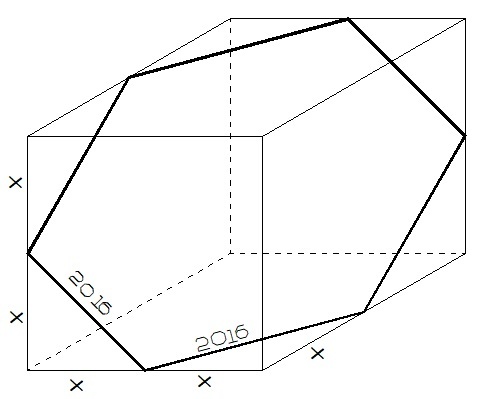Cube Sliced In Half
The diagram to the right shows a cube sliced in half.
Find the total surface area of the sliced cube to the nearest integer.
The answer is 34944783.
This section requires Javascript.
You are seeing this because something didn't load right. We suggest you, (a) try
refreshing the page, (b) enabling javascript if it is disabled on your browser and,
finally, (c)
loading the
non-javascript version of this page
. We're sorry about the hassle.
3 solutions
Assuming the two halves are symmetric, each cut edge is of length 2016, and so the new surface is a regular hexagon.
The total area is half the surface area of the cube plus the area of the hexagon of side 2016. Each 2016-long edge forms the base of an isosceles right triangle with the other two sides being half of a side of the cube. So half the side length is 2 0 1 6 / 2 , and the side length is thus 2 0 1 6 2 . The total area is therefore:
( 6 × ( 2 0 1 6 2 ) 2 ) / 2 + 3 3 / 2 × 2 0 1 6 2 = 3 4 9 4 4 7 8 2 . 8 3
 By pythagorean theorem, we have
By pythagorean theorem, we have
2 0 1 6 2 = x 2 + x 2
x 2 = 2 0 3 2 1 2 8
x = 2 0 3 2 1 2 8
2 x = 2 2 0 3 2 1 2 8
The area of a regular hexagon is given by A H = 2 3 3 a 2 where a is the side length. So the area of the hexagon is
A H = 2 3 3 ( 2 0 1 6 2 ) = 6 0 9 6 3 8 4 3
The desired surface area is half of the surface area of the cube plus area of the hexagon, we have
A = 2 6 ( 2 x ) 2 + A H = 2 6 ( 2 2 0 3 2 1 2 8 ) 2 + 6 0 9 6 3 8 4 3 ≈ 3 4 9 4 4 7 8 3
2 0 1 6 2 = 2 x 2 or x 2 = 2 0 3 2 1 2 8
So,
A = 2 1 ( 6 ) ( 2 x ) 2 + 2 3 3 ( 2 0 1 6 ) 2 = 1 2 ( 2 0 3 2 1 2 8 ) + 6 0 9 6 3 8 4 3 ≈ 3 4 9 4 4 7 8 3
Note:
surface area of a cube = 6 a 2 where a is the edge length of the cube.
area of a regular hexagon = 2 3 3 a 2 where a is the edge length of the hexagon.